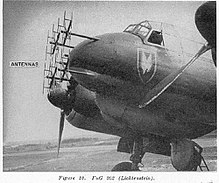
Back Radar Lichtenstein Catalan Lichtenstein-radar Danish Lichtenstein (Radar) German Radar Lichtenstein Spanish رادار لیختناشتاین Persian Liechtenstein SN-2 Finnish Radar Lichtenstein French FuG202 Japanese 리히텐슈타인 (레이더) Korean Radar Lichtenstein Portuguese



cathode-ray display:
• The left tube indicated other aircraft ahead as bumps.
• The centre tube indicated range to a specific target and whether they were higher or lower.
• The right tube indicated whether the target was to left or right.



The Lichtenstein radar was among the earliest airborne radars available to the Luftwaffe in World War II and the first one used exclusively for air interception. Developed by Telefunken, it was available in at least four major revisions, called FuG 202 Lichtenstein B/C, FuG 212 Lichtenstein C-1, FuG 220 Lichtenstein SN-2 and the very rarely used FuG 228 Lichtenstein SN-3. (FuG is short for Funk-Gerät, radio set). The Lichtenstein series remained the only widely deployed airborne interception radar used by the Germans on their night fighters during the war — the competing FuG 216 through 218 Neptun mid-VHF band radar systems were meant as a potentially more versatile stop-gap system through 1944, until the microwave-based FuG 240 "Berlin" could be mass-produced; the Berlin system was still being tested when the war ended.
© MMXXIII Rich X Search. We shall prevail. All rights reserved. Rich X Search